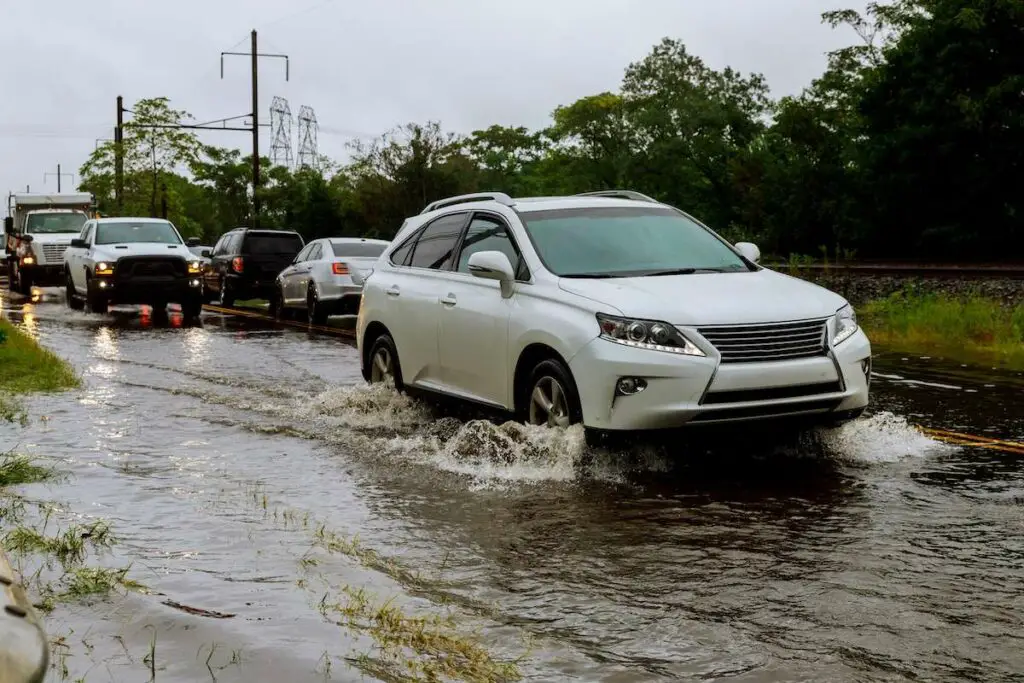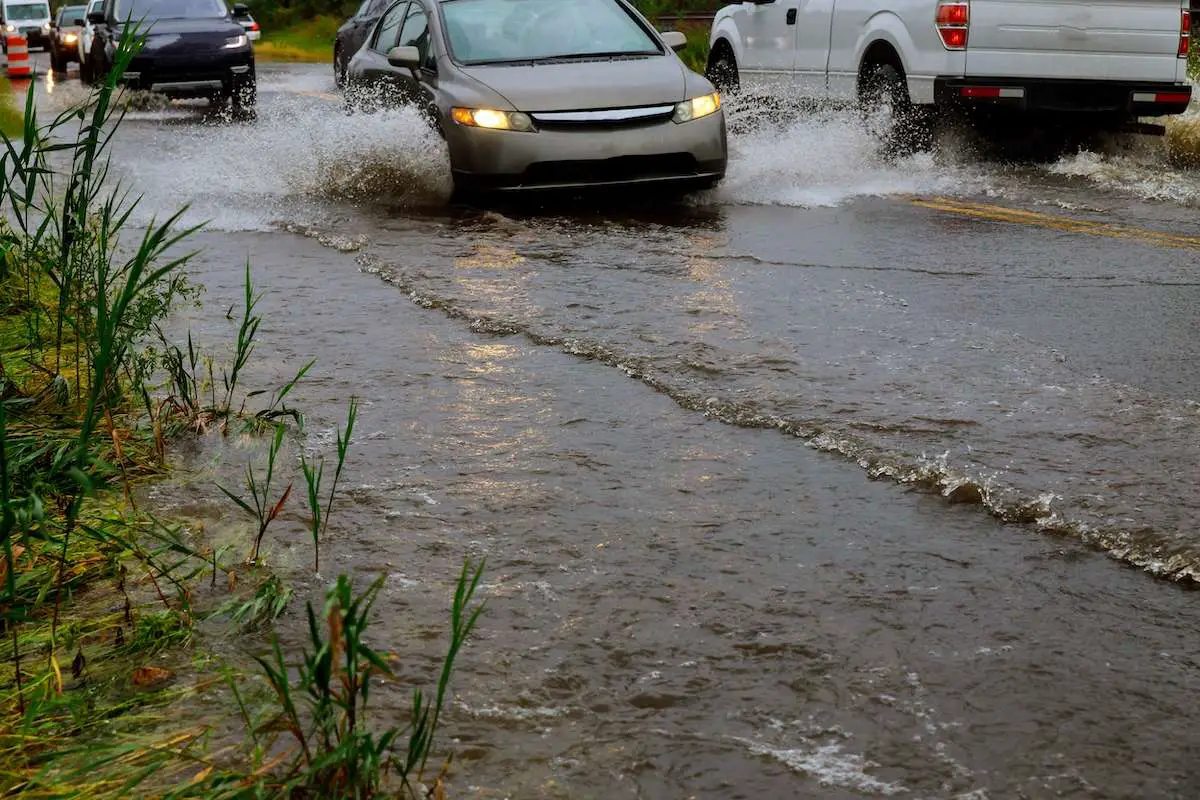Car Won’t Start After Driving Through Water? Here’s Why!
Driving a car through water can result in your car not starting or stalling while you are driving through the water. Driving a car through water can be detrimental to the car, causing several problems that will result in difficulty starting the engine or more severe damage.
Your car won’t start after driving through water because certain components have become waterlogged, preventing the engine from running. Drying the components will generally sort the problem out, and the car will start. If water enters the fuel or the engine, the problem has more dire implications.
Water can be dangerous to drive through from a practical point of view as well as a mechanical point of view for your car.
If your car doesn’t start after driving through water, there are several potential causes, some of which can be easily fixed while others are more serious and may require a mechanic’s intervention.
Pro Tip: If your car battery is dead, don’t throw it away! Check out this tutorial on how to bring your dead battery back to life and save a lot of money! This little known method is simple, quick and works for almost ANY battery out there!
Why Your Car Won’t Start After Driving Through Water?
Driving through water in your car can have some unforeseen consequences, especially if the water enters critical components of your car’s engine or electrical system.
Water from above the car, such as rain or in a car wash, usually has little effect on the car and won’t cause any starting or running problems for the engine.
Water from below is the main problem for a car since the car’s underside is unprotected, and water can get into components and cause the engine to stop.
There are two main scenarios where driving through water can cause mechanical or electrical trouble for your car; driving through water too fast or driving through water that is too deep.
Driving at high speeds through water can cause the water to splash or spray from the wheels into the engine and cause electrical and ignition problems for the engine.
Driving through water that is too deep can cause much more serious problems for your car, resulting in extensive damage to the engine.
We will discuss the various problems that can cause your car not to start after driving through water and the best course of action you can take to fix the problem.
1. The Spark Plugs Are Wet After Driving Through Water
A vehicle’s spark plugs are part of the electrical and ignition systems of the car. The spark plug leads and electrodes can become wet after driving through water too fast, causing the plugs to be splashed with large volumes of water or flooded after driving in water that is too deep.
If the spark plugs or their connections become wet, it can prevent the plugs from generating a spark, which will cause your car not to start after driving through water.
Fortunately, this damage is not severe and can generally be remedied by drying the plugs and high-tension leads.
You can unplug the plug leads and dry the end of the plug protruding from the engine using a dry cloth and also dry the connector on the plug lead to ensure a clean, water-free connection between the plug and the lead.
If you have a can of compressed air, you can use it to help speed up the drying process by spraying air over the end of the plug and the lead connector.
If you do not have a dry cloth or a can of compressed air, you can simply wait for about 20 minutes for the components to air dry.
Your car should start without any problems once the connection is restored, and the plugs can receive the current to generate the required spark in the engine.
2. The Ignition System Is Wet After Driving Through Water

Depending on your car’s age, the ignition may be controlled by a distributor cap or an electronic ignition system.
Both types of ignition systems can be affected by water and result in the car being unable to start. The difference between the two systems is what you can do about it to get the car running again.
The distributor cap is easily removed, and the inside can be dried manually with a dry cloth or with compressed air.
With an electronic ignition, you will have to wait for the system to airdry until sufficient moisture has evaporated to allow the engine to start.
3. Water Has Caused A Short Circuit In Your Car’s Electrics
Most people know that electricity and water are not best friends and do not play well together. When your car’s electrical system is exposed to water, it can cause short circuits that will prevent the car from starting.
The electrical system can become wet from flooding by driving in water that is too deep or from splashing by driving through water too fast.
Finding the exact part of the electrical circuit that has been affected by the water may not always be easy, so unless you can see anything obvious, like a fuse box that is full of water, you may have to wait until the system dries naturally.
4. Water Has Contaminated The Fuel
Water contaminating the fuel in your car is usually caused by driving through water that is too deep. The water can enter the fuel through an improperly sealed gas tank cap or the breather hole in the gas filler pipet that leads to the gas tank.
If water has entered the gas tank and contaminated the fuel, there is nothing you can do to get the car to start. The tank must be drained by a qualified mechanic, dried, and refilled with clean gas.
If the fuel has become contaminated with water at the fuel filter in the engine bay, you can clear the contaminated fuel by continuing to crank the engine to try and clear the contaminated fuel from the line.
A secondary issue you should consider is that continually cranking the motor can flatten the car’s battery, preventing the car from starting.
When the contaminated fuel has cleared, fresh, clean fuel flowing through the system should be enough to get the vehicle started. If the vehicle still has problems starting, the fuel system may need to be flushed by a qualified mechanic.
5. Water Has Entered The Engine
Water can enter the engine when driving through water that is too deep. It is generally not possible for water to enter the engine from splashes caused by driving through water too fast.
There are two main ways that water can enter the engine. If the water is too deep, it can enter the engine through the air filtration system, usually positioned on the top of the engine.
Another way water can enter the engine is via the exhaust pipe, which can result in water being sucked directly into the valves and engine cylinders.
Water entering the engine is usually catastrophic for the motor and will cause the engine to seize. The rapid cooling effect of the water in the engine can cause valves to bend or pistons to seize inside the cylinders.
This damage will likely require major repairs or an engine rebuild to get the car functioning once again and will be an expensive undertaking.
What To Do If Your Car Won’t Start After Driving Through Water?

If you have driven through water and your car won’t start, there are some things you can do to try and get your car started, even if you do not have many tools with you.
If the day is sunny, the best thing you can do is to position your car in the sun and open the hood to promote airflow through the engine bay.
The combined effect of the sun’s heat and the wind’s drying effect will help dry out engine components that have become waterlogged, preventing the car from starting.
If your car still won’t start, it is perhaps best to call for roadside assistance for your car, or reach out to a local mechanic.


![How Much Does a Car AC Leak Repair Cost? [Full Guide!]](https://vehicleuniversity.com/wp-content/uploads/2023/01/asian-automotive-mechanic-with-blue-uniform-explai-2022-01-19-00-18-40-utc-768x512.webp)

![How Often Does Car AC Need to be Recharged? [Easy Guide!]](https://vehicleuniversity.com/wp-content/uploads/2023/01/girl-driver-has-problem-with-non-working-condition-2022-08-01-04-57-51-utc-768x576.webp)
![What Kind of Acid is in a Car Battery? [With Explanation!]](https://vehicleuniversity.com/wp-content/uploads/2023/01/daily-car-check-check-out-the-distilled-car-batter-2021-08-26-17-53-37-utc-768x576.webp)
![Does AC Drain the Car Battery? [With Test Results!]](https://vehicleuniversity.com/wp-content/uploads/2023/01/ac-ventilation-deck-2021-08-26-17-12-30-utc-768x576.webp)
![AAA Car Battery Review – Is It Worth it? [Owner’s Opinion!]](https://vehicleuniversity.com/wp-content/uploads/2023/01/AAA-Car-Battery-768x512.webp)